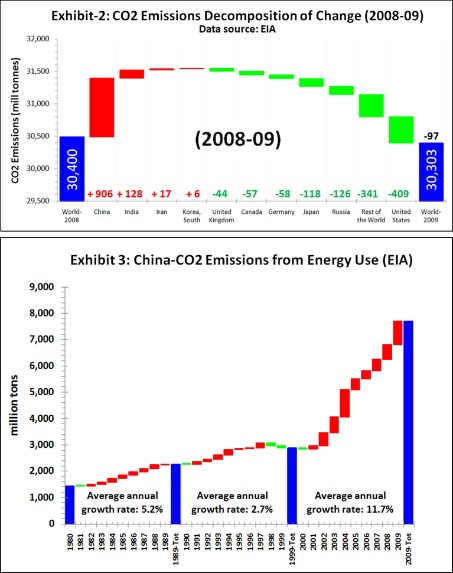Originally published at the Breakthrough Institute.
I’ve said it before and I’ll say it again: When it comes to the global climate challenge, as goes China, so goes the world.
 Soaring CO2 emissions from energy use in China drive global greenhouse-gas trends. (Click for a larger version).Graph: CO2 ScorecardDriving that aphorism home, CO2 Scorecard, a not-for-profit project that closely tracks global greenhouse-gas emissions, now reports that China’s CO2 emissions increased by 906 million tons in 2009 — the second largest annual increase for any country in recorded history. China’s soaring emissions were enough to completely offset the drop in emissions wrought by the economic havoc plaguing much of the Western world (see graphic to the right).
Soaring CO2 emissions from energy use in China drive global greenhouse-gas trends. (Click for a larger version).Graph: CO2 ScorecardDriving that aphorism home, CO2 Scorecard, a not-for-profit project that closely tracks global greenhouse-gas emissions, now reports that China’s CO2 emissions increased by 906 million tons in 2009 — the second largest annual increase for any country in recorded history. China’s soaring emissions were enough to completely offset the drop in emissions wrought by the economic havoc plaguing much of the Western world (see graphic to the right).
China’s unprecedented surge in CO2
Over the last decade, China’s annual emissions of climate destabilizing CO2 jumped by 5 billion tons per year. According to Shakeb Afsah, president and CEO of CO2 Scorecard, that’s “the highest [increase in annual CO2 output] for a single country in recorded history, representing an average annual emissions increase of almost 12 percent — more than four times the rate observed [for China] the previous decade.”
To put this unprecedented 5 billion ton increase in annual CO2 emissions in context, Afsah and colleague Kendyl Salcito note that during the 14-year-long post-war boom period of 1959-1973, during which U.S. CO2 emissions rose each year, America’s annual output of CO2 jumped by only 2 billion tons.
This new analysis comes on the heels of the latest International Energy Agency’s World Energy Outlook, which projects China’s soaring demand will single-handedly account for 36 percent of all global energy demand growth over the next 25 years. According to the global energy watchdog group, China’s energy use will rise 75 percent between 2008 and 2035, raising the nation’s share of global energy use to 22 percent, up from 17 percent today.
Sliding backwards?
Despite a much-publicized national climate policy centrally focused on driving down the CO2 intensity of the Chinese economy through greater industrial and power plant efficiency, the amount of carbon emitted per unit of economic output in China slid backwards during four of the last 10 years. In 2009, after four years of steady progress, the carbon intensity of China’s economy took a big step backwards, regressing to 1999 levels, according to CO2 Scorecard:
 Click for a larger version. Graph: CO2 Scorecard
Click for a larger version. Graph: CO2 Scorecard
That factoid means there’s more going on here than just simple economic growth driving emissions growth. China’s macroeconomic policies are actually driving the carbon intensity of the nation’s economy backwards, working at cross-purposes with the central government’s avowed climate strategy.
The analysts at CO2 Scorecard point the finger at China’s promotion of an export-oriented manufacturing economy, including the nation’s increasingly controversial currency policies.
Since joining the World Trade Organization in 2001, China has built up a manufacturing juggernaut that has taken over global supply chains for some of the world’s most energy intensive industrial processes, including cement, steel, glass, and chemicals production, turning predominately to carbon-intensive coal to fuel this economic engine. That was a recipe for both soaring economic output and carbon emissions alike.
The recent impact of the global recession has only exacerbated China’s outsized role in global emissions. According to CO2 Scorecard:
Through the global recession, China’s depressed exchange rate protected its energy intensive industries, serving as a subsidy for export-oriented manufacturing industries (Wolf 2009). Other countries that would have grown their industrial sectors couldn’t compete against China’s deflated prices. So China has ended up with a lion’s share of industrial production within its economic pie, subjecting itself to a sub-optimally large share of CO2 emissions and other industrial pollution.
China’s carbon commitments: ambitious or lackadaisical?
To meet a targeted 40-45 percent reduction in carbon intensity by 2020, announced in November 2009 as China’s pledge at global climate negotiations in Copenhagen, China’s central government has recently forced the closure of inefficient factories and power plants, enforced planned blackouts, and launched other seemingly heavy-handed steps to reduce the energy intensity of the national economy.
Despite these high-profile measures, analysts, including Breakthrough Senior Fellow Roger Pielke Jr., have repeatedly warned that China’s seemingly ambitious climate target really just amounts to continuing on a course of business-as-usual — which would mean another decade of unprecedented emissions growth.
Afsah and Salcito note that this latest evidence adds credence to such concerns. “Though impressive on paper,” China’s carbon intensity pledge “represents the status quo,” the duo writes.
Between 2005 and 2008, China’s average annual CO2 intensity reduction rate was 4.35 percent, according to CO2 Scorecard’s analysis. Simply continuing that business-as-usual rate would see China’s emissions shrink 45 percent in around 13 years — by 2018, or two years ahead of their pledged goal.
“Maintaining the 4.35% reduction rate would not require any additional effort on China’s part,” Afsah and Salcito write. But hitting their goal in 2020 instead of 2018 would mean China could even slack off a bit, requiring just a 3.9 percent annual reduction.
“China is not just setting itself up for a business-as-usual carbon intensity reduction plan; it has committed to a lazier plan, allowing its emissions to continue increasing for an extended period of time,” write Afsah and Salcito (see graphic above).
A recipe for rebound?
Worse yet, China’s primary focus on improving industrial energy efficiency as the key to meeting carbon intensity goals is almost perfectly designed to trigger rebounds in energy demand that erode or even negate climate gains from such measures.
As noted in Breakthrough Institute’s February report, “Energy Emergence: Rebound and Backfire as Emergent Phenomena,” energy efficiency measures lower the effective price of the services derived from fuel consumption — heating, cooling, transportation, industrial processes, etc. — thus triggering a rebound in demand for those services (see a FAQ on rebound effects here).
These “rebound effects” are likely to be particularly pronounced in both industrial sectors and in developing nations, like China, where demand for goods and services, including energy services, is far more elastic (responsive to changes in price), and where industrial productivity improvements are key drivers of economic growth. For every step forward taken through efficiency, rebounds in energy demand take China — and the world — one or more steps backwards away from climate mitigation goals.
Thus, increased efficiency, particularly in China’s industrial sectors, will drive greater economic growth and energy use. The net effect: total CO2 emissions are likely to keep soaring, even as China meets its lackadaisical carbon intensity goals.
Breaking China’s carbon dependence
Is there any way then to really break the link between China’s soaring economic output and soaring emissions?
Pursuing China’s current path of unambitious carbon intensity goals — principally met with industrial efficiency efforts likely to trigger serious rebounds in energy demand — looks like a recipe for continued disaster.
And while CO2 Scorecard’s Afsah and Salcito note that a halt to China’s currency depreciation efforts and other economic policies designed to spur an exports and industrial manufacturing-fueled growth strategy would cool both emissions and economic growth rates, this analyst considers it unlikely that China will assent to policies that drive down carbon by simply slowing economic growth.
That leaves only one other real option then: de-link economic growth from carbon emissions by fueling China — and the world — with clean, affordable, and massively scalable energy technologies.
Unfortunately, the menu of technologies that meet all three of those criteria — clean (e.g. zero or very low-carbon), cheap (e.g. relatively affordable compared to conventional fossil fuels), and massively scalable — is still quite limited. Cleaner energy alternatives must continue to improve in price, performance, or both, to meet a “China-sized” appetite for energy.
China, America, Europe, and the rest of the world must rapidly accelerate the pace of improvement in a whole suite of clean energy technologies, from nuclear and solar alike to plug-in hybrid vehicles, energy storage, and advanced biofuels. And a whole set of next-generation energy technologies must cross the valley of death from laboratory to commercialization in the coming decades.
On this point, a cadre of energy experts including analysts at the International Energy Agency, U.S. Energy Secretary Steven Chu, dozens of Nobel laureates, high-profile American business leaders, and leading think tanks, are all united: We must make clean energy cheap, and fast.
China is already on a roaring path towards single-handedly swamping any hopes of climate stability, and success is far from assured.
The only thing that is certain is that the clock is ticking, and there’s no time to waste in developing clean, cheap, scalable energy technologies to fuel both China and the world. The entire climate challenge hinges on our ability to do just that.
As the writer and environmental activist Bill McKibben is fond of saying, “You can’t negotiate with the planet.”
Bill’s right of course. But as TIME magazine environmental correspondent Bryan Walsh observes, “it turns out you can’t negotiate with the human desire for growth and development either — not in any political system on this planet. We need policies that provide us with the energy for both — or we may end up with neither.”



